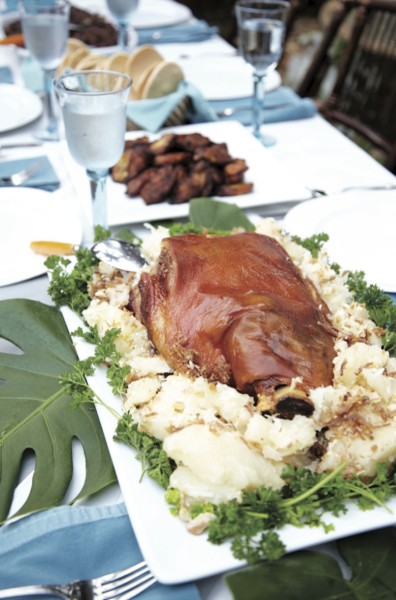My plan was never to cancel Christmas but only to relocate it. After years of lobbying, I persuaded my mother to join me and my sister in Brooklyn by taking full responsibility for making our traditional Cuban Nochebuena, or Christmas Eve dinner: frijoles negros (black beans), plátanos maduros (fried ripe plantains), the starchy root called yuca dripping in sour orange mojo, and the all-important lechón asado, a crackly-skinned roasted pork shoulder.
My sister and I had both left Miami years ago for colleges in Manhattan then stayed, eventually sharing an apartment in Brooklyn: It was a big move because it had been just the three of us since my father died. In exchange for the guiltless freedom our mother gave us, we dutifully made our way home every year to celebrate Christmas with our extended family of aunts, uncles and cousins the same way they had since coming to the United States from Cuba in the early 1960s.
When they all lived in Havana, family gatherings were a weekly occurrence at my maternal great-grandparents’ Miramar home, so maintaining that tradition, especially at this time of year, was important to everyone.
For me, though, it meant spending the holidays in airports, living out of a suitcase and sleeping in a bedroom that had long been converted into an office. While I couldn’t complain about getting a break from the cold, it was hard to leave my Cobble Hill neighborhood at the pinnacle of its winter-white loveliness, and for once I wanted to stay here.
Moving the meal to Brooklyn would mean more than a change of scenery. In Miami, the lechón alone is an all-day endeavor. My uncle George chooses a live pig from a nearby farm and has it prepared for La Caja China — a plywood roasting box lined with aluminum that, since it’s creation in Miami by Roberto Guerra in the late 1980s, has replaced open-pit pig roasts and digging up the yard with a shovel for Cuban men all over South Florida.
After marinating overnight in naranja agria (sour orange), cumin, oregano and countless cloves of garlic, the pig is set inside the box between two metal racks, then covered with an ash pan that is topped with a charcoal fire. Over the next five hours, everyone keeps a steady vigil around the box, tending the burning coals, talking about how lovely the pig was and how delicious it’s going to be, essentially turning the holiday into what amounts to a pig wake.
This was clearly impossible to achieve in a Brooklyn apartment, so I opted for the simpler, oven-roasted version of lechón designed for smaller gatherings. Making a frantic call to Tía Meme in Florida for the recipe — technically my father’s cousin, though she has always been called an aunt, or tía, out of respect — I set out to find the tropical ingredients she dictated over the phone and got ready to put down some holiday roots in the city I’d come to love.
I started at Batista Grocery in Essex Market on the Lower East Side, a warren of family-owned retail stands and food stalls that for many years primarily served the surrounding Puerto Rican and Dominican populations. I stocked up on hard-to-come-by sour oranges, dried beans that never sit around long so you’re guaranteed a fresh bag and coconuts the store workers deftly crack open with the tap of a machete. I even left with competing recipes from the women who run the cash register for coquito, the Puerto Rican eggnog made with spiced coconut milk and plenty of rum.
My next stop, at Los Paisanos on Smith Street in the Boerum Hill neighborhood of Brooklyn, was closer to home. Though technically a multi-generation Italian butcher shop, you are as likely to hear Spanish there as anything else, thanks to its Latin-American staff members. Waiting my turn, I lucked out when the Dominican counterman knew the pierna (leg) my aunt Meme described was the same cut as the pernil (roast pork) his mother made. I asked him to choose a pretty one, and he put down the pork shoulder he’d started to wrap and brought out a different one from the back — rosy pink with an even layer of pure white fat and plenty of skin to make chicharrón, or crispy pork crackling. It was gorgeous.
As the shoulder marinated, I focused on the mojo that’s poured over Cuban-style cooked yuca or the green-skinned winter squash called calabaza, as well as anything else that needs drenching. It’s similar to the citrus-based marinade for the lechón but made with the addition of boiling manteca, or lard, and requires a tightly covered skillet and quick hands to contain the furious whirring and popping when the hot fat hits the juice in the pan.
I might have been scared off if the directions hadn’t come from my sweet tía Alicia, an older cousin like Meme, who’d been making it that way for decades. Her only advice: Do it carefully. I could have substituted olive oil, but G. Esposito & Sons Pork Store a few blocks southwest of Los Paisanos has always kept a steady supply of freshly rendered lard for the neighborhood’s Italian grandmothers, and there was no need to compromise.
As flights arrived and local friends who were like family joined us for the meal, I really got to work. The frijoles negros were in the final stages — where the beans are tender and the onion and green pepper–based sofrito has melted into the thickening black liquid — when I almost lost them to over-salting. A quick call to my aunt Cristina — the black bean expert — put me back on track with more water and low heat.
I tried to do it all myself, but my kitchen was soon full of eager guests and hungry taste testers. Platters of yuca, plantains and garlic-infused white rice made it out to the table someone helpfully set. There was no roasting box to gather around, so everyone hovered near the stove, turning the shoulder skin-side up and cranking up the heat to get the prized burnt-red pork crackling.
For dessert, there was an ambitious bûche de Noël with almond ganache bark, and meringue mushrooms alongside powdery mantecados, or shortbread laced with anise seeds. My mother produced gold-edged boxes of Spanish turrónes, or nougat, from the suitcase in the bedroom she’d gamely set up in our office. We passed around small shots of black Cuban espresso and talked and laughed the rest of the night.
When I had time to take it all in, I realized I loved how our Brooklyn meal had turned out, but I knew I wouldn’t repeat it anytime soon. I missed seeing palm trees strung with lights, and keeping my aunts and uncles on the phone lines wasn’t the same as having them near. It was enough to know that I could pull off a New York Nochebuena, albeit with lots of help — but that as long as I could find my way home, I wouldn’t have to.
Photo credit: Ellen Silverman



